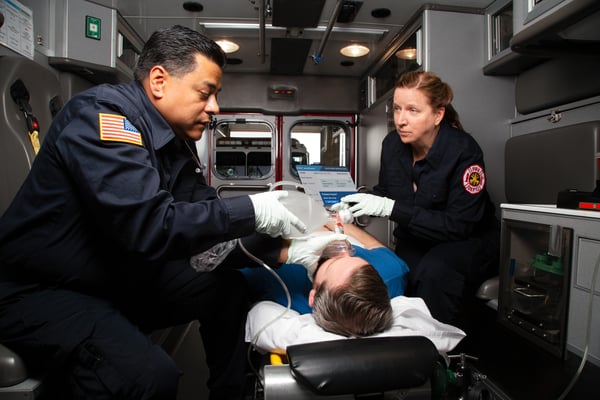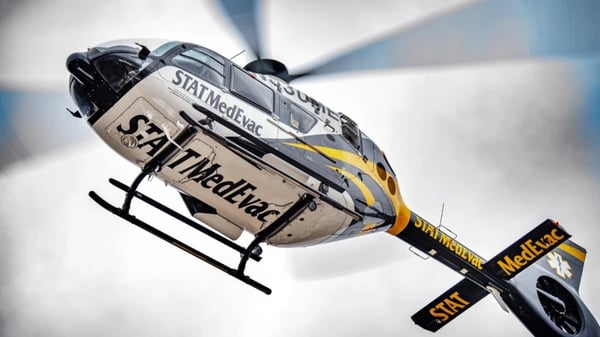News Alert: New ePCR Integration Simplifies EMS Data Management and Enables Better Care Coordination
App Lets You Keep Charting Through the Chaos
Suited for providers’ personal devices, ZOLL® emsCharts® NOW is streamlined for contemporaneous use even when there’s no connection
Was this information valuable?

Suited for providers’ personal devices, ZOLL® emsCharts® NOW is streamlined for contemporaneous use even when there’s no connection.
In an underground parking garage, two vehicles have collided, and several patients are injured. First responders arrive quickly, but the scene is chaotic, with multiple victims to triage. Some are children, some are elderly, some are bleeding, one is clutching her chest – the first-in crew has a lot to sort through. And it’s a busy day, so reinforcements might take a while.
However that crew spends the next few minutes, one thing they likely won’t be doing is significant charting – care priorities mean that will have to wait. They’ll manage urgent threats like hemorrhage and that possible chest pain and make sure those patients are sent on their way to the hospital or home – and then, in a moment of downtime, they’ll get around to filling in the details of their patient care reports (PCRs).
That’s not optimal. Providers trying to finish their documentation after the call concludes may have trouble remembering key details – drugs, times, vital signs, sequences of events. It’s common to scrawl notes on everything from wrappers to gloves, but even these can be lost, misread or illegible. The result can be incomplete or inaccurate documentation, which can have consequences for downstream care and beyond.
It’s a problem that afflicted providers at New Jersey’s Delran Emergency Squad like everyone else. In response, its leaders tried several solutions to help providers chart more contemporaneously during calls.
“We tried iPads. We tried Toughbooks. We’ve tried to have these different devices with us as we were doing our assessments,” said Chief Chuck McSweeney. “And a lot of times we found those devices just ended up in the bags, not used.”
What does get used, by Delran’s young workforce and American workers in general, is smartphones. The company lets its personnel access their personal devices at work, and like most millennials, its members do so regularly. Those phones and other personal devices ended up holding the answer to better charting and all the benefits that follow.
Buttons Make Documentation Easier
ZOLL Data Systems’ new ZOLL emsCharts NOW mobile app brings the easy functionality of the company’s cloud-based ZOLL emsCharts ePCR solution to providers’ personal devices and gives them a way to record key aspects of their patient care simply and in real time, rather than trying to reconstruct everything they did later.
Delran leaders gave the app an early trial and liked it so much, they took it departmentwide.
“We give our personnel access to all the ZOLL emsCharts products out there, and I now have a total of 27 employees using ZOLL emsCharts NOW in a wide variety of ways,” McSweeney said. “They value their own phones, so they take better care of them on the job. And if they can do specific things within the application, just by pressing a button, to manage documentation issues and make their lives easier, they’re willing to do it.”
With ZOLL emsCharts NOW users initiate charts with a single button tap. The app creates a master timeline where actions are entered and displayed with time stamps in chronological order. A trip information screen simultaneously provides a summary overview. CAD information is imported and updates dynamically, and pickup and destination address pages are supported by easy links to Google Maps for turn-by-turn directions.
A unique feature eases one of the main aggravations of charting by automatically importing patients’ key identifying information with a simple scan of the barcode on the back of their driver’s license. That ensures name and address accuracy for billing purposes. Adding medical histories is simplified through a button wall of common conditions drawn from years’ worth of ZOLL emsCharts records. Those can be added to charts with a tap, as can common allergies. Other buttons jump to longer lists of less-common possibilities. Basic medications are handled similarly.
Care interventions are documented using configurable quick-action buttons. Dropdown menus list potential actions, which are time-stamped as they’re completed. Stopwatches track the times and durations of key interventions. Data is saved with a tap or automatically when backing out of pages.
That’s all not only streamlined, but it can also happen offline when connectivity is lacking – say, in places like underground garages – with data stored on the local device until it can be uploaded later to ZOLL emsCharts storage in the cloud. From there it integrates neatly into companion products like the ZOLL Care Exchange and ZOLL Billing platforms.
All this provides caregivers at the scene, hospital teams and data analysts back at HQ the most complete and accurate picture possible – with documented and time-verified vital signs, treatments and responses – of all patients and the care they received.
Chart Integrity Pays Off
In the Delran Emergency Squad’s trial, McSweeney and four of his clinicians used ZOLL emsCharts NOW for almost half a year.
“Our parameters were that it needed to be within our workflow process and not delay patient care or create more steps in getting the patient in the ambulance and transported,” the chief said. “And it had to be integrated with the way we do things from the point of dispatch.”
Delran’s users provided regular feedback to ZOLL Data Systems, which used the process to provide some final refinements. Now, McSweeney says, charts are being completed faster and with more integrity. Scanning the drivers’ licenses prevents transcription errors and ensures the accuracy of more than two dozen data points.
“If we can avoid typing in the demographic information, that’s a win,” he said. “Once you spell somebody’s name wrong or get their birth date off by one number, it makes it harder to do things like insurance discovery. So taking the human element out of it with just the ID scanner for the driver’s license was amazing. My billing department loves it.” Some calls have actually been billed the same day the patient was transported.
Employees who don’t have to stay late to finish their charts are happy too. They especially like the quick-action buttons, McSweeney says, which help them easily document standards of care that meet the Joint Commission’s National Patient Safety Goals. And that in turn makes chiefs and physicians happy too.
“I used to say I could fly patients all day long,” said McSweeney, a former flight medic. “The job was amazing – until I had to sit down to do a chart. So this kind of innovation, using technology at the bedside that doesn’t hinder our workflow, is huge for us. We tried other things, but they always seemed to interrupt the flow of charts. I think this is the first product that really, truly gives us that piece.”
Read More About Contemporaneous Charting and Data Sharing:
Why Rapid Access to EMS Data Is Essential for Excellence in Cardiac Systems of Care
Related Posts
4 Must-have Data Points for Dispatch-Billing Alignment and Maximum Reimbursement
How STAT MedEvac Connected Device, Software, and Data Technology To Enhance QA and Elevate Care
ZOLL Pulse Blog
Subscribe to our blog and receive quality content that makes your job as an EMS & fire, hospital, or AR professional easier.
ZOLL Pulse Blog
Subscribe to our blog and receive quality content that makes your job as an EMS, fire, hospital, or AR professional easier.




